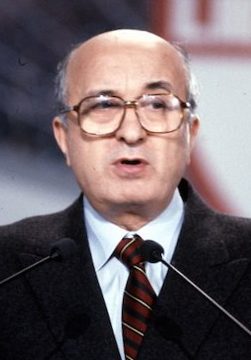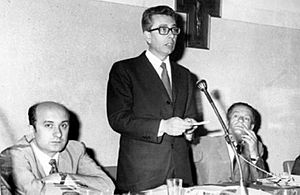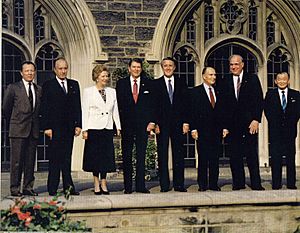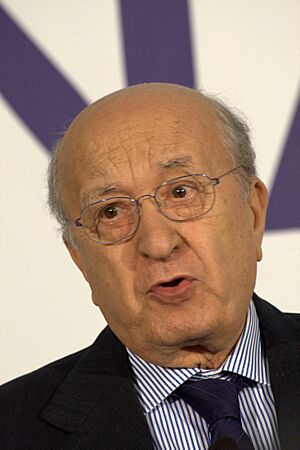Ciriaco De Mita facts for kids
Quick facts for kids
Ciriaco De Mita
|
|
|---|---|
 |
|
| Prime Minister of Italy | |
| In office 13 April 1988 – 23 July 1989 |
|
| President | Francesco Cossiga |
| Deputy | Gianni De Michelis |
| Preceded by | Giovanni Goria |
| Succeeded by | Giulio Andreotti |
| Minister for Interventions in Southern Italy | |
| In office 30 July 1976 – 21 March 1979 |
|
| Prime Minister | Giulio Andreotti |
| Preceded by | Giulio Andreotti (by delegation of functions) |
| Succeeded by | Michele Di Giesi |
| Minister of Foreign Trade | |
| In office 23 November 1974 – 30 July 1976 |
|
| Prime Minister | Aldo Moro |
| Preceded by | Gianmatteo Matteotti |
| Succeeded by | Rinaldo Ossola |
| Minister of Industry, Commerce and Crafts | |
| In office 8 July 1973 – 23 November 1974 |
|
| Prime Minister | Mariano Rumor |
| Preceded by | Mauro Ferri |
| Succeeded by | Carlo Donat-Cattin |
| Secretary of the Christian Democracy | |
| In office 5 May 1982 – 22 February 1989 |
|
| Preceded by | Flaminio Piccoli |
| Succeeded by | Arnaldo Forlani |
| Member of the Chamber of Deputies | |
| In office 9 May 1996 – 28 April 2008 |
|
| Constituency | Campania |
| In office 16 May 1963 – 14 April 1994 |
|
| Constituency | Benevento (1963–1987; 1992–1994) Liguria (1987–1992) |
| Member of the European Parliament | |
| In office 14 July 2009 – 1 July 2014 |
|
| In office 19 July 1999 – 19 July 2004 |
|
| In office 24 July 1984 – 13 April 1988 |
|
| Constituency | Southern Italy |
| Mayor of Nusco | |
| In office 26 May 2014 – 26 May 2022 |
|
| Preceded by | Giuseppe De Mita |
| Succeeded by | Walter Vigilante |
| Personal details | |
| Born |
Luigi Ciriaco De Mita
2 February 1928 Nusco, Campania, Italy |
| Died | 26 May 2022 (aged 94) Avellino, Campania, Italy |
| Political party | DC (1956–1994) PPI (1994–2002) DL (2002–2007) PD (2007–2008) UDC (2008–2017) IP (2017–2022) |
| Spouse |
Anna Maria Scarinzi
(m. 1958) |
| Children | 4 |
| Relatives | Giuseppe De Mita (nephew) |
| Alma mater | Catholic University of Milan |
Luigi Ciriaco De Mita (born February 2, 1928 – died May 26, 2022) was an important Italian politician. He served as the Prime Minister of Italy from April 1988 to July 1989. The Prime Minister is the head of the government in Italy.
De Mita was a member of the Christian Democracy (DC) party. He was the party's secretary and leader from 1982 to 1989. This made him one of the most powerful politicians in Italy. He was also a key member of the party's left-leaning group. During his long career, he held several government jobs. He was the Minister of Industry, Commerce, and Crafts from 1973 to 1974. He also served as Minister of Foreign Trade from 1974 to 1976. From 1976 to 1979, he was the Minister for Interventions in Southern Italy.
De Mita was a member of the Chamber of Deputies (like a parliament) for over 40 years. He served from 1963 to 2008. He was also a Member of the European Parliament. Later in his life, De Mita became the mayor of his hometown, Nusco. He served as mayor from 2014 until his death in 2022.
Contents
Early Life and Education
Ciriaco De Mita was born in Nusco, a town in the Avellino area, in 1928. His father worked as a tailor and a postman. His mother was a housewife. Ciriaco was a very good student. He went to a classical high school in nearby Sant'Angelo dei Lombardi.
He earned a scholarship to attend the Augustinianum College. Then, he studied at the Catholic University of the Sacred Heart in Milan. He graduated with a law degree. After university, he worked as a consultant for the legal office of Eni, a large energy company.
Political Journey
As a young man, Ciriaco De Mita joined the Christian Democracy (DC) party. This was the start of his political career. In 1953, De Mita helped create "La Base," a group within the party that had more left-wing ideas. He quickly moved up in the party. In 1956, he became a member of the party's national council during a big meeting in Trento.
In the 1963 national election, he was elected to the Chamber of Deputies. He represented the area of Benevento–Avellino–Salerno. He remained a deputy without interruption until the 1994 elections. In 1968, De Mita became an undersecretary of state for the Ministry of Interior. This was his first government role.

De Mita was appointed deputy secretary of the Christian Democracy party in 1969. He worked under the leader Arnaldo Forlani until February 1973. During the 1970s, De Mita held several important jobs in the government.
- He was the Minister of Industry, Trade, and Crafts from July 1973 to November 1974. He served in the government of Mariano Rumor.
- He was the Minister of Foreign Trade from November 1974 to July 1976. He served in the government of Aldo Moro.
- He was the Minister for Special Projects in Southern Italy from July 1976 to March 1979. He served in the government of Giulio Andreotti.
Leading the Christian Democracy Party
In 1982, De Mita was chosen as the secretary of the Christian Democracy party. His main goal was to make the party more modern and active. However, the party lost many votes in the 1983 election. In 1986, De Mita was re-elected as secretary. He had the support of 60% of the party members.
His time as leader is remembered for his rivalry with Bettino Craxi. Craxi was the leader of the Socialist party and served as Prime Minister for four years in the 1980s. Craxi often said his reforms were better than the Christian Democrats' slow pace. In 1987, Craxi and De Mita disagreed over a deal called the "relay pact." This deal said that the Socialist Party (PSI) would let the Christian Democracy party lead the government in the last year of the term. Craxi refused to do this, which led to an early election in 1987.
In 1984, De Mita encouraged Sergio Mattarella, who later became president of Italy, and Leoluca Orlando to get more involved in politics. Their job was to help clean up the Christian Democracy party in Sicily from the influence of organized crime. De Mita made Mattarella a special leader for Palermo.
De Mita remained the secretary of the party until February 1989. After that, he became the president of the party. He held this position until 1992.
Serving as Prime Minister
After the 1987 elections, De Mita waited a year to become Prime Minister. He was appointed on April 13, 1988. His government was a coalition of five parties, known as the Pentapartito. Just three days later, on April 16, 1988, a terrorist group called the Red Brigades killed Senator Roberto Ruffilli. Ruffilli was an advisor to De Mita.
De Mita's government received approval from the Chamber of Deputies on April 21. His main goal was to reform Italy's political system. This included changes to the Italian Parliament, the Prime Minister's office, local governments, and the rules of the Chamber of Deputies.
In June 1988, his government agreed to move 72 U.S. Air Force F-16 fighter jets to Italy. This happened after Spain asked for them to be removed from its territory.
In terms of social policy, De Mita's government passed a law in May 1988. This law created a new benefit for workers called "benefit for the family nucleus." The amount of money depended on how many family members there were and the family's income from the year before.
De Mita resigned on May 19, 1989, because of ongoing disagreements with Craxi. He tried to form a new government, but he was not successful. His government finally ended in July 1989. Giulio Andreotti then became the new Prime Minister on July 23.
Later Political Roles
In September 1992, De Mita was chosen to lead a special group. This group was called the Bilateral Commission for Constitutional Reform. Its job was to suggest changes to Italy's constitution. He left this role in March 1993.
De Mita did not run for re-election as a deputy in the 1994 elections. However, he ran again in 1996 and was elected. He was also re-elected in 2001 and 2006. During this time, he joined the Italian People's Party and later the Democracy is Freedom – The Daisy party until 2008.
De Mita also served as a Member of the European Parliament. He was a member from 1999 to 2004, and again from 2009 to 2014.
On May 25, 2014, De Mita was elected as the mayor of Nusco, his hometown. He was re-elected in 2019 and served as mayor until his death in 2022.
Family Life and Passing
In 1958, Ciriaco De Mita married Anna Maria Scarinzi. They had four children: one son and three daughters. Their children are Antonia (born 1967), Giuseppe (born 1969), Floriana (born 1973), and Simona (born 1974). His nephew, Giuseppe De Mita, also became a member of the Chamber of Deputies from 2013 to 2018. Ciriaco helped his nephew start his political career.
Ciriaco De Mita passed away on May 26, 2022, at the age of 94. He was recovering from surgery for a broken leg, which he got after falling at home. His funeral was held the next day in Nusco.
Electoral History
| Election | House | Constituency | Party | Votes | Result | |
|---|---|---|---|---|---|---|
| 1958 | Chamber of Deputies | Benevento–Avellino–Salerno | DC | 39,431 | ||
| 1963 | Chamber of Deputies | Benevento–Avellino–Salerno | DC | 67,450 | ||
| 1968 | Chamber of Deputies | Benevento–Avellino–Salerno | DC | 65,231 | ||
| 1972 | Chamber of Deputies | Benevento–Avellino–Salerno | DC | 127,876 | ||
| 1976 | Chamber of Deputies | Benevento–Avellino–Salerno | DC | 112,792 | ||
| 1979 | Chamber of Deputies | Benevento–Avellino–Salerno | DC | 169,431 | ||
| 1983 | Chamber of Deputies | Benevento–Avellino–Salerno | DC | 203,252 | ||
| 1984 | European Parliament | Southern Italy | DC | 1,055,233 | ||
| 1987 | Chamber of Deputies | Genova–Imperia–La Spezia–Savona | DC | 84,726 | ||
| 1992 | Chamber of Deputies | Benevento–Avellino–Salerno | DC | 106,819 | ||
| 1996 | Chamber of Deputies | Mirabella Eclano | PPI | 33,326 | ||
| 1999 | European Parliament | Southern Italy | PPI | 105,288 | ||
| 2001 | Chamber of Deputies | Mirabella Eclano | DL | 37,504 | ||
| 2006 | Chamber of Deputies | Campania 2 | DL | – | ||
| 2008 | Senate of the Republic | Campania | UDC | – | ||
| 2009 | European Parliament | Southern Italy | UDC | 56,967 | ||
Source: Ministry of the Interior
See also
 In Spanish: Ciriaco De Mita para niños
In Spanish: Ciriaco De Mita para niños



